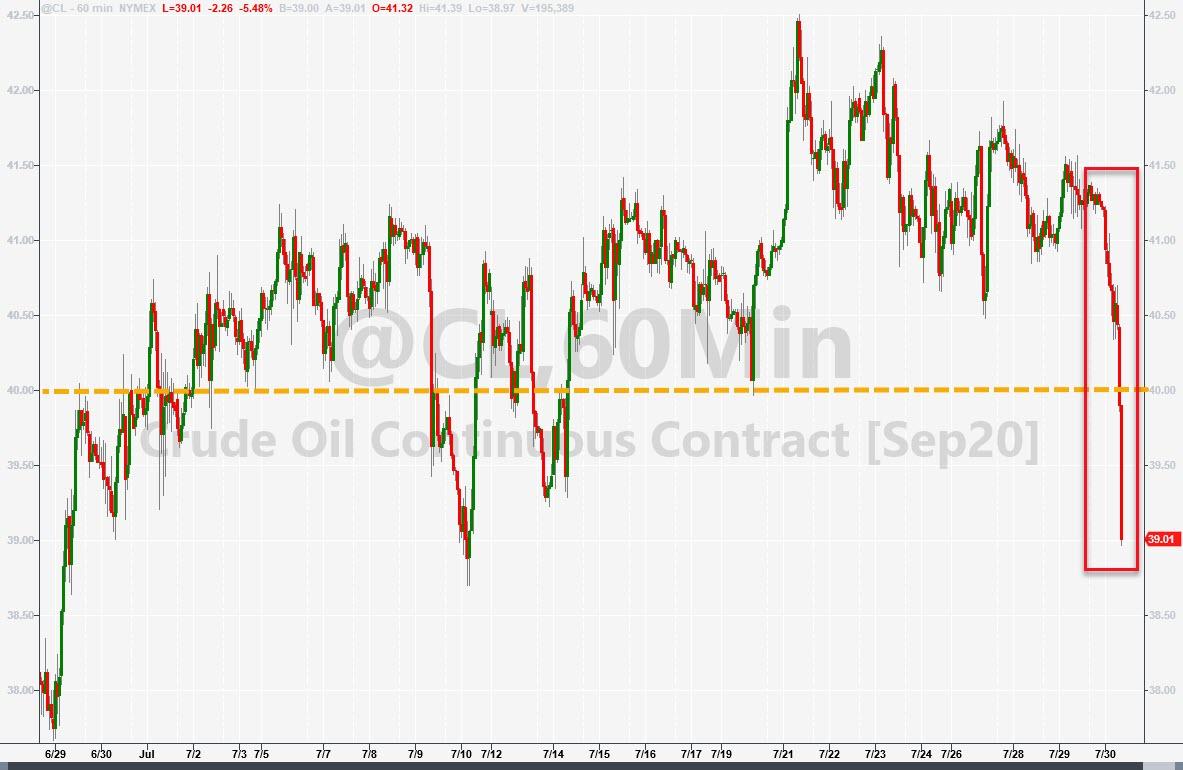Oil Prices Plummet, WTI Accelerates Below $40 As Demand Fears Rise
Tyler Durden
Thu, 07/30/2020 – 10:26
On top of the Fed-described “extraordinarily uncertain” economic outlook, this morning’s GDP data spooked oil prices lower and it appears $40 stops have been busted…
While fears of a US resurgence of COVID have moderated modestly in recent days, the market remains caught between output cuts from some of the world’s biggest producers and anxiety over demand as Asian nations begin to see a 3rd wave.
“Positive and negative factors still appear balanced on the oil market, with concerns about weak demand being offset by the voluntary OPEC+ production cuts,” said Eugen Weinberg, head of commodities research at Commerzbank AG.
This won’t help the economy ‘recover’ as energy-related job losses transform from temporary to permanent, and as OilPrice.com’s Nick Cunningham notes, several analysts argued this week that the bigger picture is murkier, with economic and pandemic-related risks looming.
“While upwards momentum has stalled over the past month, we still think prices are overdue a downwards correction to reflect the flattening of oil demand recovery and the darkening of economic prospects,” Standard Chartered analysts wrote in a note.
The investment bank added that “consensus views” on the oil market balances in the second half of the year have “weakened significantly over the past month.”
“We now only rarely hear talk of V-shaped demand recoveries and extremely tight markets, the views that allowed Brent to rally beyond USD 40/bbl,” Standard Chartered said. “Instead the main talk among traders seems to have shifted to precisely how much demand will disappoint and how long will it take to normalise inventories.”
That assessment stands in stark contrast to the behavior of crude prices in the last six weeks. Volatility has vanished, with WTI remaining rooted at about $40 per barrel, and Brent a few dollars more. Prices have been stuck at those levels even as the optimism surrounding economic re-openings has dissipated. The only sign of a more pessimistic outlook creeping into oil markets is the shift from backwardation towards contango. As Standard Chartered pointed out, the discount for front-month Brent contracts relative to fourth-month Brent contracts has widened over the course of July.
“In our view, Brent above USD 40/bbl seems increasingly discordant with the flow of news regarding the coronavirus pandemic and the outlook for the global economy, and particularly jars with increasingly bearish oil market fundamentals,” Standard Chartered analyst concluded.
However, on the flip side, U.S. gasoline demand jumped in latest EIA data through July 24, rising to 8.8 million barrels per day (mb/d), ending several weeks of decline, at least temporarily. That level of consumption is the highest in four months.
Moreover, the surge in cases in the United States has eased ever-so-slightly, with key states such as Texas, Florida and California seeing infections coming down from recent peaks. “This could be a sign of retreating demand risks from possible slowdowns or targeted lockdowns, but the prospect of a second wave later in the year still presents looming risks,” ClearView Energy Partners wrote in a note to clients.
The second wave in the U.S. may be plateauing for the time being, and the rebound in gasoline demand combined with the drawdown in inventories boosted oil prices midweek.
But the sentiment shifts from week to week, and it is not clear that the prevailing wisdom that oil markets would be in a substantial supply/demand deficit in the second half of the year will pan out. On Tuesday, Rystad Energy warned that the loosening of the OPEC+ production cuts could lead to a renewed surplus for the next four months.
Global supply is expected to increase rather significantly over the next several months, outpacing expected demand increases. “OPEC’s experiment to increase production from August could backfire as we are still nowhere near out of the woods yet in terms of oil demand. The overall liquids market will flip back into a mini-supply glut and a swing into deficit will not happen again until December 2020,” Bjornar Tonhaugen, Rystad Energy’s Head of Oil Market Research, said in a statement on Tuesday.
On Wednesday, Tonhaugen stuck with that thesis, despite the price increase on the back of EIA data. Rystad pointed to the unexpected rise in infections in Europe, a negative development that has yet to be factored in to market expectations. In fact, data from Europe shows a decline in road traffic as virus cases rise. “[D]on’t be fooled by today’s price gains, they may be cancelled as soon as production exceeds demand, which is around the corner, and as this is expected to last for some time, traders will race to price it in,” Tonhaugen said.
via ZeroHedge News https://ift.tt/2D5P2qn Tyler Durden
